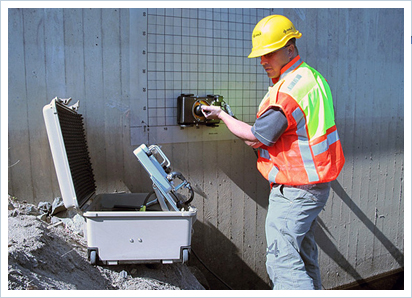Unwinding the Beneath: Concrete Scanning and Imaging
Wiki Article
Past the Surface: Unwinding the Keys of GPR Scanning for Concrete Applications
Are you ready to dive deeper into the world of GPR scanning for concrete applications? Discover the basics of GPR scanning, discover exactly how it works, and check out ideal methods for carrying out scans on concrete surfaces.The Basics of GPR Scanning for Concrete Applications
GPR scanning is typically used to assess the condition of concrete structures. When you make use of GPR scanning, you can quickly untangle the keys that lie below the surface of the concrete. It provides you with valuable information about the interior framework of the concrete and assists you determine any type of potential issues or issues.With GPR scanning, you can quickly and non-destructively establish the density of the concrete piece and locate any type of gaps or delaminations within it - Concrete Scanning and Imaging. This info is important for evaluating the structural integrity of the concrete and planning any necessary repairs or upkeep
Moreover, GPR scanning allows you to identify the existence of enhancing steel bars, likewise called rebar, within the concrete. This is essential for evaluating the toughness and durability of the structure, along with for ensuring appropriate building techniques were followed.
Additionally, GPR scanning can spot the existence of moisture or water seepage within the concrete. This is specifically crucial as wetness can cause corrosion of the enhancing steel, which can endanger the structural stability of the concrete in time.

Understanding the Modern Technology Behind GPR Scanning
To comprehend how it works, you require to understand the innovation behind GPR scanning. Ground Penetrating Radar (GPR) is a non-destructive screening approach that makes use of electromagnetic waves to detect subsurface items and features. The antenna receives the reflected waves and sends out the information back to the control unit.GPR scanning operates the concept of time traveling. The control device determines the time it considers the waves to take a trip to the subsurface and get better. By analyzing the time and strength of the mirrored waves, GPR can identify the deepness and location of items within the concrete. Different products have special electromagnetic properties, which influence the way the waves are mirrored. This enables GPR to identify in between concrete, rebar, gaps, and various other subsurface features.
Ideal Practices for Conducting GPR Scanning on Concrete

Analyzing GPR Scanning Outcomes for Concrete Applications
As soon as you have performed the GPR scans on the concrete, it's time to analyze and translate the outcomes to gain beneficial understandings. The analysis of GPR scanning results is an important step in comprehending the problem of the concrete and determining any type of potential problems. When analyzing the GPR data, you ought to start by seeking abnormalities or variations in the signals. These anomalies might indicate the visibility of spaces, splits, or other defects within the concrete. Take notice of any adjustments in signal strength, form, or depth, as these can give vital details about the concrete's condition.Along with determining problems, the interpretation of GPR results can also help identify the thickness and composition Find Out More of various concrete layers. By assessing the representations and diffractions in the GPR information, you can approximate the deepness and density of different layers, such as the concrete cover, reinforcement, or any other ingrained aspects. This info is crucial for examining the architectural honesty of the concrete and preparing any type of necessary repair or upkeep job.

Advanced Techniques for GPR Scanning in Concrete Analysis
By using advanced methods, you can boost the accuracy and resolution of GPR scans for evaluating concrete frameworks. One such technique is called multi-frequency GPR scanning. This involves utilizing GPR systems that can run at numerous regularities at the same time. By doing so, you can obtain extra comprehensive info about the concrete's inner structure. Another strategy is referred to as time-lapse GPR scanning. This involves taking multiple scans of the exact same area at different times and comparing the results. By doing this, you can track any type of modifications or deterioration in the concrete in time. Furthermore, using ground-coupled antennas can enhance the high quality of GPR scans. These antennas are put in straight call with the ground surface area, enabling much better signal penetration and resolution. Incorporating innovative information processing algorithms can also boost the precision of GPR scans. These formulas can remove sound and improve the presence of subsurface functions. In general, by making use of these innovative strategies, you can significantly boost the effectiveness of GPR scanning in analyzing concrete frameworks.Final Thought
So there you have it - the tricks of GPR scanning for concrete applications have actually been unraveled. Since you recognize the read this basics of this modern technology and exactly how it functions, you can confidently carry out GPR scanning on concrete structures. Bear in mind to adhere to finest methods and interpret the outcomes accurately to make certain exact analysis. And if you're feeling daring, don't hesitate to explore advanced techniques in GPR scanning. With this expertise, you'll be able to dig past the surface and reveal the hidden keys of concrete structures.Discover the essentials you can try these out of GPR scanning, find out exactly how it works, and explore finest practices for conducting scans on concrete surface areas. When you make use of GPR scanning, you can conveniently untangle the tricks that exist beneath the surface area of the concrete. The interpretation of GPR scanning results is a critical step in understanding the problem of the concrete and identifying any possible concerns. On the whole, by utilizing these advanced strategies, you can greatly enhance the effectiveness of GPR scanning in evaluating concrete structures.
Now that you comprehend the basics of this innovation and just how it works, you can with confidence perform GPR scanning on concrete frameworks.
Report this wiki page